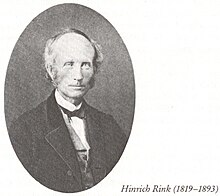Hinrich Johannes Rink
Hinrich Johannes Rink , also Hendrik or Hinrik (born August 26, 1819 in Copenhagen , † December 15, 1893 in Christiania ) was a Danish geologist , Greenland explorer and inspector of Greenland.
Life
Hinrich Rink was the son of Johannes Rink and Agnese, née Hedde. Both came from Dithmarschen . Hinrich Rink married the writer Nathalia Sophie Nielsine (Signe) Caroline, née Møller (* 1836 in Godthåb), daughter of the inspector Jørgen Nielsen Møller . They had a daughter together.
Rink studied physics and chemistry at the University of Copenhagen and became Dr. phil at the Christian-Albrechts-Universität zu Kiel and attended medical lectures in Berlin until 1845. There he received the invitation to participate as a mineralogist in the circumnavigation of the frigate Galathea . He actually wanted to go to Calcutta with the Galathea, but ended up with the Nicobar Islands , who were then colonized by Denmark. After five months he fell ill with a fever that would weaken him for life. He had to return to Denmark, where his first major geographical work appeared in 1847: "The Nicobar Islands" (in German).
Then Rink explored North Greenland with public support from 1848 to 1851 . Rink lived among the native Inuit for four years . He made the first geological map of the Greenland coast. But he was very interested in exploring the inland ice. As the first scientist he explored its origin and movement and the causal connections with the icebergs in the North Sea. In 1853 he published his treatise "Om Isens Udbredning og Bevægelse over Nordgrønlands Fastland" (On the spread and movement of the ice over the north Greenland mainland). Rink returned to Copenhagen as early as 1851, where he took a seat on a commission that considered the monopoly trade in Greenland. On behalf of this commission he returned to Greenland in 1852, toured southern Greenland and published the work "Om Monopolhandelen paa Grønland" ( About the monopoly trade in Greenland ). In 1853 he entered the service of the monopoly trade and was initially colonial administrator in Godthåb (Nuuk) and Julianehåb (Qaqortoq). During this time his main work "Grønland, geografisk og statistisk beskrevet" ( Greenland described geographically and statistically ) was created, which was the first standard work on Greenland after Hans Egedes "Perphia" (1729). From 1857 to 1868 he was the royal inspector of South Greenland , succeeding his father-in-law.
Rink actively cared for the well-being of the Inuit, with whom he was in close contact. So it was his idea, and under his leadership, that the executive boards were established which ensured the Greenlanders influence over their affairs. In 1858 he called on the local population to artistically process and record the Greenlandic traditions, and also provided them with material support. Artists like Jens Kreutzmann and Aron von Kangeq were discovered and promoted. In 1861 he set up a printing house in Godthåb, where the first Greenlandic newspaper, Atuagagdliutit ( Readable ), which was also founded by Rink, appeared. Rink studied the Greenlandic language and the Greenlandic folklore. In 1866 “Eskimoiske Æventyr og Sagn” (Eskimo fairy tales and legends) was published.
In 1868 he was forced to leave Greenland for health reasons and went to Copenhagen. There he was director of the Royal Greenland Trade from 1871 to 1882 , as which he headed the entire administration of the country - with the exception of the missionary system. He continued to try to be active in the interests of the Inuit by continuing the Greenlandic executive boards under his leadership. In Copenhagen he founded the Grønlænderhjem (Greenlander Home) for young Inuit who were in Denmark for training.
In 1882 he moved to Christiania (now Oslo), where his daughter was married. There he finished his last work. He died in 1893 as the most important Greenland expert of his time.
Among other things, Rink left behind a collection of over 140 manuscripts with maps of Greenland that he and others had drawn. This collection can now be seen in the Royal Library in Copenhagen. A monument was erected in his honor in Nuuk.
In honor of Hinrich Johannes Rink, Det Grønlandske Selskab has awarded the Rink Medal for special scientific commitment to Greenland since 1960 .
plant
Of his writings on Greenland, which Rink has made a great contribution to researching, the most important, apart from various articles in Petermann's Geographical Communications :
- Greenland, described geographically and statistically (Copenhagen 1852–55, 2 volumes; English edition by Brown, London 1877)
-
Fairy tales and legends of the Eskimos (Copenhagen 1866, Suppl. 1871; English 1875)
- Eskimoiske Eventyr og Sagn . Copenhagen 1982
- Tales and traditions of the Eskimo . Mineola 1997
- Inland Greenland and the Opportunity to Travel to It (Copenhagen 1875)
- Greenlanders and Danes in Greenland (Copenhagen 1888)
all in Danish ; he also published The Nicobar Islands (Copenhagen 1847) in German . After his death, The Story of Kagsagsuk was published (Leipzig, Insel-Verlag 1914).
literature
- Hinrich Johannes Rink . In: Carl Frederik Bricka (Ed.): Dansk biografisk Lexikon. Tillige omfattende Norge for Tidsrummet 1537-1814. 1st edition. tape 14 : Resen – Saxtrup . Gyldendalske Boghandels Forlag, Copenhagen 1900, p. 125 (Danish, runeberg.org ).
Individual evidence
- ↑ Heinz Barüske: Greenland: culture and landscape of the Arctic Circle . DuMont, Cologne 1990, ISBN 3-7701-1544-9 , pp. 107 .
- ↑ The memorial in Nuuk (see photo) incorrectly gives December 31, 1894 as the date of death. December 15, 1893 is confirmed by the church book of the Trefoldighetskirke in Oslo .
- ↑ Kongelig Library
| personal data | |
|---|---|
| SURNAME | Rink, Hinrich Johannes |
| ALTERNATIVE NAMES | Rink, Henry; Rink, Henrik |
| BRIEF DESCRIPTION | Danish geologist and Greenland explorer |
| DATE OF BIRTH | August 26, 1819 |
| PLACE OF BIRTH | Copenhagen |
| DATE OF DEATH | December 15, 1893 |
| Place of death | Christiania |

